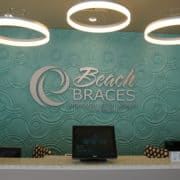What are Lingual Braces?
Last Updated on September 2, 2021 by editor
Unlike traditional braces that are placed on the front of the teeth for the entire world to see, lingual braces are placed on the inside of the teeth facing the tongue. In fact, the word “lingual” means tongue. From the outside, even up-close, they are just about invisible. Sometimes referred to as “inside” braces, they are similar to traditional braces in terms of orthodontic principles and the type of hardware used.
Contents
- 1 Why do People Choose Lingual Braces? People of both genders and all ages that have considered braces have decided on lingual braces.
- 2 Are There People Who are Not Good Candidates for Lingual Braces?
- 3 Lingual Braces Pros and Cons
- 4 What is the Treatment Procedure?
- 5 Your Orthodontist Takes Impressions of Your Teeth
- 6 How Much do They Cost?
- 7 How do Orthodontists Feel About Them?
- 8 Don’t Forget to Take Your Before and After Braces Pictures
- 9 If you Live in Manhattan Beach, CA, You’re in Luck
Why do People Choose Lingual Braces?
People of both genders and all ages that have considered braces have decided on lingual braces.
- Many patients that come to an orthodontist for lingual braces are public and professional figures who feel their orthodontic treatment shouldn’t be a focus when they’re in public. Because lingual braces are practically invisible, they suit their lifestyle.
- Other patients, like many adolescent or adult actors or models for whom appearance is paramount, want straight teeth without showing traditional braces during treatment.
- For many, it’s a matter of not sharing with the world the fact that they’re undergoing a treatment plan. Lingual braces help keep it a private matter.
- Lingual braces are also a good choice for people who play sports or wind instruments.
Are There People Who are Not Good Candidates for Lingual Braces?
While there are considerations that may eliminate certain individuals from being a good candidate, the best way to determine if they’re the right choice for you is to consult with your orthodontist. There are, however, issues your orthodontist will consider.
- Lingual braces are not recommended to correct excessive bite problems like an overbite.
- Those with small teeth are not good candidates for the procedure.
Lingual Braces Pros and Cons
Pros
- The most obvious advantage is cosmetic.
- Lingual braces are an excellent option for minor anterior movements like crowding, spacing, tipping, rotation, midline discrepancy and intrusion/extrusion.
- Even if the minor discoloration that sometimes occurs with braces happens, it’s on the inside where it can’t be seen.
- They’re less visible than clear plastic, removable tooth aligners.
- Lingual braces allow the Orthodontist more control than with removable aligners, and patient compliance is a non-issue.
- Your braces will be custom fabricated just for you, compared to conventional braces that often use stock parts.
Cons
- Plaque buildup can become a problem.
- Overall time for the treatment is sometimes longer than for traditional braces, and office appointments can be longer too.
- Because the brackets are custom-made, lingual braces cost more than traditional braces.
- There is an adjustment period because the placement behind the teeth affects the tongue. Swallowing and even speaking takes some getting used to.
- It’s important to keep them clean, but it can be difficult.
MTM® No•Trace™ – See How It Works
What is the Treatment Procedure?
You’ve had a consultation with your orthodontist. You’ve had your exam and x-rays, and you’ve decided to get lingual braces. Through advanced robotic wire bending technology and the use of CAD/CAM, your braces will be custom fabricated.
It’s a pretty involved process.
Your Orthodontist Takes Impressions of Your Teeth
The impressions of your upper and lower teeth will be extremely detailed and accurate. The brackets and wires are made at the dental laboratory. They also outline the final desired alignment outcome.
Next, the Fabrication Process Begins
- Using the impressions from your orthodontist, the lab will make casts.
- Based on instructions from your orthodontist, the lab creates a mockup, or “setup,” of your teeth in perfect alignment.
- The hardware is created and the setup is scanned into a computer.
The Brackets are Returned to Your Orthodontist
- Your newly fabricated brackets are imbedded into an applicator tray that fits over your teeth. This process holds them in place during the bonding procedure.
- But, you’re not done yet. Your hardware is left with your orthodontist for the final fabrication process.
- Be prepared to wait a few weeks before your next appointment to have them attached to your teeth.
Now would be a good time to take a “before” picture for your before and after braces comparison when your treatment is finished.
Attaching the Braces
- First, the surface of your teeth will be prepared so the bonding will properly adhere.
- Your orthodontist will apply the cement, or bonding agent, to the brackets.
- The applicator tray will be pressed into place over your teeth until the cement has cured, ensuring precise alignment.
- When the cement has set and the applicator tray has been removed, your brackets will remain in place.
- Finally, the pre-bent arch wire prepared by the laboratory can be installed.
You’ll be back in the office every few weeks to have the brackets tightened to ensure your teeth are being straightened according to plan.
How Much do They Cost?
Because of the sophisticated technology and robotics used to create custom fabricated braces, lingual braces generally cost more than other options, like traditional, ceramic and removable aligners. Examine the lingual braces pros and cons. Ask yourself just how important the cosmetic advantage is in your daily life. Do your research. If you decide that it’s worth a little more, then it’s worth a little more.
How do Orthodontists Feel About Them?
- The use of lingual braces is more common in other part of the world than in the U.S.
- Not all orthodontists who have already completed educational requirements beyond those of a dentist have an interest in additional specialized training.
- Providing treatment presents some difficulties for the orthodontist related to visibility and access.
- Orthodontists that have completed the specialized training, however, can offer their patients the additional option of lingual braces, making their practice more patient-friendly.
Don’t Forget to Take Your Before and After Braces Pictures
It’s easy to take that beautiful new smile for granted. Look at the before picture once in a while and you’ll be reassured it was worth it.
If you Live in Manhattan Beach, CA, You’re in Luck
Beach Braces Orthodontics, located in Manhattan Beach, specializes in orthodontics for adults, teens and children and would be happy to consult with you regarding all the options available to achieve your perfect smile.
Beach Braces, 220 N. Aviation Blvd. Suite A
Manhattan Beach, CA 90266
TEL: 310-379-0006
What are Lingual Braces?
[super-post id=”sp54c9d3dd4e3a0″ title=” Related Posts” items=”5″ show_title=”true” title_length=”0″ title_ellipsis=”…” show_thumbnail=”true” remove_no_thumbnail=”false” icon_height=”40″ icon_width=”40″ icon_empty=”3612″ show_comments=”true” comment_icon=”https://www.beachbraces.org/wp-content/plugins/super-post/images/comments.png” show_date=”true” show_date_link=”true” date_icon=”https://www.beachbraces.org/wp-content/plugins/super-post/images/date.png” date_format=”F j, Y” show_author=”false” author_title=”View all posts by {author}” author_icon=”https://www.beachbraces.org/wp-content/plugins/super-post/images/author.png” show_category=”false” first_category=”true” category_separator=”, ” category_icon=”https://www.beachbraces.org/wp-content/plugins/super-post/images/category.png” offset=”0″ page_range=”5″ load_text=”Load more posts” query=”related” order=”DESC” post_status=”publish” title_trim=”words” load_style=”none” template=”left”]

Dr Patti Panucci attended the University of Louisville School of Dentistry for four years, where she graduated with a DMD degree (May 2000) among the Top 10 in her class. Following that, she headed west to Los Angeles to complete her three-year residency at one of the top-ranked orthodontic programs in the country – the University of Southern California.
Along with her certificate in orthodontics, Dr. Panucci earned a master’s degree in craniofacial biology. During those three years, she fell in love with Southern California beach life and decided that this was where her future lay.













Trackbacks & Pingbacks
[…] Why do People Choose Lingual Braces? […]
Leave a Reply
Want to join the discussion?Feel free to contribute!